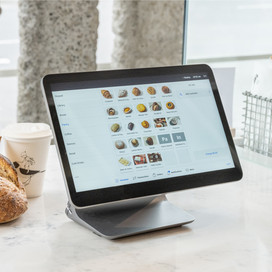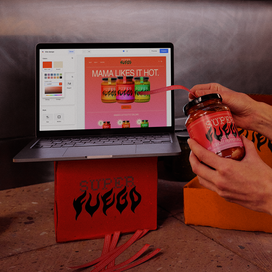Table of contents
We’ve all heard the term ‘brand’, but what does it really mean to have a brand? They don’t spring out of nowhere, and a lot of thought and planning goes into creating a successful brand. You may also think that because you start a business, you automatically have a brand. That’s not really true, because while you may have a unique business name, a brand is much more than that.
In this article, we’ll take a look at what a brand is, the different types of brands out there, and how to build a brand for yourself.
What is a brand
A brand is more than just a name and logo. If you can learn how to create a brand, you’ll have an identifiable platform from which to market your business to the world. A brand incorporates many tangible things, including:
- Name
- Logo
- Brand colours
- The fonts you use
- Tone of voice
- What do you stand for
Most of these are self-explanatory, but it’s the last item on this list that really separates your business from the rest. In today’s world, people love to support a business that they can resonate with. Some businesses exist to provide the cheapest possible solutions to a problem. Others exist to provide ethical alternatives to common products. Whatever you stand for becomes an important part of your brand.
Different types of brands
There is more than just one brand type out there. While all brands have the same basic set of features, they look very different depending on the type of brand you’re creating.
1. Corporate brands
Corporate brands, as the name suggests, are more business-oriented. The main focus when developing corporate branding is to stand out from the crowd and make yourself more easily identifiable in the marketplace. When you build a corporate brand, there is a strong focus on pricing, company mission and values, and of course, the target market. These factors will inform how the brand looks, sounds and appears in marketing material.
2. Personal brands
Personal brands are a big thing in today’s world. When you look at how people make money these days, there are so many who do it through various online forums. It might be as a social media influencer or YouTube creator. These people all create a personal brand, which dictates how they present themselves, the type of content they develop, and how they interact with followers.
Other people who use personal brands are consultants or industry thought leaders. Although, having a personal brand isn’t limited to executive types. If you’re looking to advance your career in any field, it pays to have a personal brand that’s reflected across all of your social media.
3. Product brands
Product branding focuses more on one particular product, rather than a business. In most cases, if the company developing the product already has a brand, it will end up being similar. That’s because the values and the mission of the product usually match that of the company. However, when building a product brand, particular attention must be paid to the target audience. This informs how you’ll sell the product, the pricing and much more.
4. Service brands
Service brands are a little different, because they exist to market a particular service. Much like product brands, they will usually link closely to the company’s overall brand. However, the target audience may be different, for example, if the company is trying to break into a new market with a different type of service. This might also lead to different colours, tone of voice and presentation to appeal to a different audience.
How to create a brand
Creating a brand may sound simple in theory, but a lot of work goes into it. However, following some key steps will have you well positioned to grow your brand the right way. It’s important to keep in mind that your brand doesn’t necessarily need to follow the norm. You can stand out with completely unique branding, and in a crowded marketplace, that can sometimes be the best approach.
That being said, there are a few accepted conventions that will help you position yourself well for your target audience. From local businesses to online stores, branding is crucial. Let’s take a look at how to create a brand in 6 easy steps.
1. Conduct a market research
Understanding your market is the first thing you should do, before you even decide on a name. This is important not just for branding, but for business planning in general. If the market isn’t there, or if you can’t compete in the existing market, you need to re-think your strategy.
You can hire a company to do this research for you, or alternatively do some work yourself online. Check out competitors on Google, look at their social media accounts, and even search online in the shoes of a customer. Find out who your audience is, who your established competitors are, and also identify competitors you want to go head-to-head with. For example, you won’t compete with a brand like Amazon, but you can certainly compete with smaller players.
2. Pick a focus for your brand – what makes you unique?
We’ve already discussed the importance of standing for something. It’s important to find out what this is, and more importantly, if it matches the values of your target audience. For example, if you want to sell designer jewellery and your focus is using ethically sourced materials, is this something your target audience really cares about? It’s more likely they’re concerned with the highest-quality materials and most innovative designs. So, it makes sense to make those things your focus. Of course, ethics and sustainability are important in any market, but they may not be your sole focus.
3. Settle on a business name and slogan
It may seem strange to leave it this late in the game to choose a business name, but in reality, your business name should encompass the things you’ve already thought about. It needs to appeal to your target audience, be something they can identify with. It should also be aligned to your core focus and values, which you’ve now established.
There are plenty of ways to come up with a business name. There are even business name generators online if you’re really stuck. But be creative and choose the right name. Think about a word associated with your brand, and perhaps spell it differently. Or combine it with another relevant word. You can even be a bit more straightforward and explain exactly what you do, for example, ‘The Local Taco Bar’.
Then, it’s a matter of picking a catchy slogan to go with it. Your slogan may or may not sit underneath your logo – the choice is yours. But it’s important to have one. Think about well-known slogans, such as Hungry Jack’s “The burgers are better at Hungry Jack’s”. That simply describes what they offer, but it’s memorable. Nike uses “Just Do It”, which is motivational and applies to their products.
Remember, your slogan can change over time. Most companies adopt new ones as their identity or target audience shifts.
4. Colours and fonts
You may not realise it, but certain colours are often attached to certain feelings. Colours like blue are supposed to evoke a feeling of trust, which is exactly why blue is the main colour of so many tech companies. Red is all about excitement – think food and drink brands like Coca Cola and Kelloggs. So, do a little research on the psychology of colours and choose something that suits your brand, but also something you love.
The same applies to the fonts you use. This one is important, because you should try to consistently use the same fonts across all of your marketing material, including your website. The best idea is to choose two main fonts. One is for headings, one is for standard text. Any more and it just becomes confusing, and you miss out on that consistency you’re after.
5. Logo design
You’re now at the point to consider designing a logo! This is the image that will represent your business basically everywhere, so it needs to be perfect for you. There is a lot of conjecture out there about what makes a good logo, but the general advice is to keep it simple. Look at brands like Apple and Google – they both have very basic designs. Starbucks is a huge company and their logo is more complex, but they’re probably in the minority.
You can do anything with a logo, such as choose an image to represent your brand, abbreviate your business name, or even use your full business name. There’s no right or wrong, but keep one thing in mind. Your logo needs to serve as an avatar online, such as on social media and even on web browsers. So, if you choose to just use your name, also have a small image that suits online avatars and favicons.
6. Tone of voice
Finally, you’ll need to look at your tone of voice. You’ll apply this in your website content, written communication, social media posts and any blogs or articles you create. So, you want it to reflect the way you want your business to be seen. Will you always be professional and informative, or more playful and fun? Again, think of your target audience and what they will respond best to.
Your brand can always evolve
Remember that your brand can always change. It’s great to develop your brand before you hit the marketplace, but that doesn’t mean you’re locked in. Down the track, you may find your target audience changes, so you can adjust your tone of voice or even colour schemes. As long as any future changes are well-informed and done for a good reason, then just like your business, your branding can always evolve.
![]()












